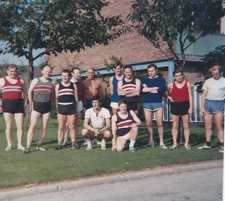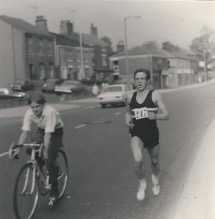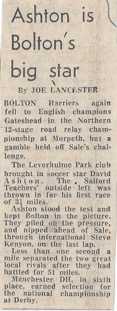David Ashton – A Lifetime in Athletics (Part 2)
If you haven’t done so already, be sure to read part one of David’s memoir
September 1964 I’d taken the option of staying on at my secondary modern school. Great for academic possibilities but a real problem for a sports lover because school teams were under-15’s and age barred me from these.
Question: What does one do faced with this problem? Answer: Join a running club.
Question: What’s the first move? Answer: Speak to the P.E. teacher and get a list of local clubs.
Confronted with this list I picked out Manchester YMCA Harriers and sent off for details. From the very first I was made to feel welcome and part of a team. This latter proved very important because a) I was the only youngster and, b) it was not the most successful of clubs. My first run in October 1964, at the club still carries distinct memories. I was met at the Peter Street headquarters and taken to the club training ground on Princess Parkway. The run was two laps, of 3 mile on the road. Considering I’d never run on the road and never covered more than two or three miles cross-country it proved a steep learning curve. Despite this I soon became familiar with harrier running and competed for the club as a Youth, Junior and Senior from 1964 to 1970. The season’s fixture programme was very different than today’s all year race calendar. The winter months were the only programmed fixtures. We were part of the Manchester cross-country league which consisted of four races and there were championship races for the East Lancs, Northern and National. Vacant Saturdays consisted of Pack Runs from Moss Nook and taking in the countryside round Manchester Airport.

Above: Manchester YMCA Harriers at the start of a Pack Run in the 1960’s. We don’t exactly look the mean and lean figures of harrier running but enjoyment and comradeship was high on the agenda. Manchester YMCA Harriers at the start of a Pack Run in the 1960’s. We don’t exactly look the mean and lean figures of harrier running but enjoyment and comradeship was high on the agenda.
Road relays usually 4 x 3 mile were very popular at the start and finish of the cross-country season and were really enjoyable events. Most clubs staged them including the YMCA who used their 3 mile training loop. The Longendale event was staged by Salford Harriers and because of it’s geographical location attracted top clubs from Manchester, West Yorkshire and Staffordshire.

Above: Competing in the Longendale relay, September 1969. The cyclist is pure coincidence – I was not being paced, HONEST!
Manchester YMCA Harriers did not cater for track athletics in a serious way and this was a problem because that was by far my favourite form of running. I was invited to track sessions at Bolton under the direction of Terry Nortley and this led to a situation of racing for Bolton on the track and the YMCA at harrier events.
In Autumn, 1970, I joined Bolton United Harriers as a first claim member and consequently experienced athletics where the basic aim was achievement of self and team. In my years at Bolton I was primarily part of the track team and only ever on the fringes of those great harrier teams of the 60’s and 70’s with runners of the stature of Ron Hill, Mike Freary and Steve Kenyon. I loved the track sessions and although we regularly trained to exhaustion it remains my favourite type of training. Many of you will have experienced Steve Symons excellent sessions and the benefits these bring. My favourite session was 12 x 200m in teams of two. We were paired with a runner of equal ability. One runner started half-way along the straight and ran to their partner on the opposite straight. Once you had handed over the recovery was a jog across the track ready for the incoming runner. It was lung bursting because you had to be in position ready for the in-coming runner.
On Sunday mornings the track team trained round Entwistle reservoir between Bolton and Blackburn. These, too, carry great memories. As well as runs around the reservoir we did hill-reps in the forests and reps up the steps of the dam-head embankment. Running on pine needles and their soft cushioning impact remains my favourite ever running surface. The reps up the dam’s head carry different memories – those 147 steps still give me nightmares. Sadly I have barely any photographs of my Bolton days. However, two newspaper cuttings best highlight my memories of being part of a top club.

Bolton Evening News – March 1971

Manchester Evening News – March 1973
Both articles are correct but each has a story behind the report.
The two races cover my best and worst performance for the club. In the medley relay it is true I was overtaken within yards of receiving the baton in first place. What the report doesn’t highlight is the disgust and annoyance I could sense from the Bolton support even whilst running. For the first lap there were token cheers and encouragement. As the race progressed and it was clear I was “sitting-in” on the lead runner those cheers loudened with shouts of “you can do it!”, “use your strength!” and “take him!, take him!”. Remember I’ve already stated races were about achievement of self and club. (How different to the raucous cheers from our lady members who shout encouragement following their race in cross-country races. These cheers are for all standards).
The second report is again factually true but really does carry a story behind it. My services were called upon on the Thursday before Saturday’s race. It was before the days of emails and texts and as we didn’t have a phone at home the message came through from the team manager at work. The race was very important as Bolton needed to finish in the first six to qualify for the National Championships. Our team was considerably weakened by injuries and Ron Hill racing in a marathon in Athens. We travelled as a team on the Friday and stayed overnight at Newcastle University. Once settled in a team meeting was called and the twelve runners were given a race order and a six or three mile leg. I was to run the three mile, sixth leg. An early start Saturday on the short journey to Morpeth to look over the course and further discuss tactics. With the race underway I took over in third place and by the end of my leg I had dropped down to sixth. From this point I was not flavour of the month. (I now appreciate how own goals and penalty misses affect footballers). Luckily everything turned out well and a second place finish was an excellent result for the club.
This is where I went from zero to hero and I got all the plaudits from media coverage because mine made a good story. It is ironic that I got a Northern Counties silver award for this, my poorest race for the club, and a six-pack of lager for my finest in the medley relay. This difference is compounded for someone who doesn’t drink. Needless to say my services were not required for the National Championships.
Reading this I hope I’ve not given the impression that my Bolton career was fraught. It was not and I loved the experience of running at a top club, and knowing I’d achieved my full capabilities.
I’ll finish part 2 with an anecdote of how crazy runners can get. In 1971 a small group of Bolton track athletes travelled to a relay meeting in Edinburgh. Nothing unusual here you’ll be thinking. However, the only reason was to say we had run on a tartan track. Nowadays these are common and every park seems to have them. In 1971 there were only two in the country – Crystal Palace and Edinburgh. I’m sure you’ll agree its this “craziness” that makes ours such a great sport to be part of.
— David Ashton, July 2016